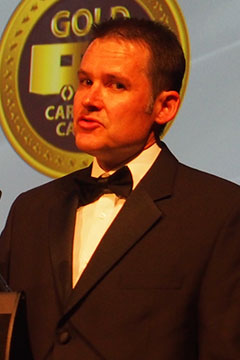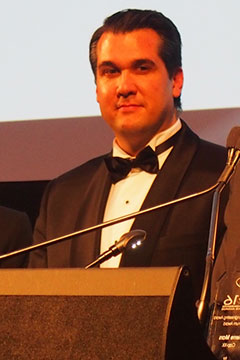The winning Cap-XX products were for application in hybrid passenger cars, where the supercapacitor can handle sudden large flows of electricity during regenerative braking, and for use in truck batteries, where a supercapacitor battery can start even a 16-litre diesel engine in bitterly cold conditions.
A range of other awards were announced for developments including a virtual system for determining how difficult it is to get into a new vehicle, even while the design is still on a CAD (computer aided design) system, and for an improved caravan antenna that can be made mostly on 3D printers.

Winning feeling: Federal MP Michael Sukkar (left) and founder and chief executive of Cap-XX Anthony Kongats at the Society of Automotive Engineers-Australasia (SAE-A) gala dinner in Melbourne.
The new supercapacitor technology was developed jointly in the 1990s by the CSIRO (Commonwealth Scientific Industrial and Research Organisation) and businessperson Anthony Kongats, founder and chief executive of Cap-XX. They are made under licence by two offshore companies, although Cap-XX does have some manufacturing capacity in Australia.
A supercapacitor has much greater energy storage capacity than lead-acid batteries for a given volume and can also charge and discharge much faster.
Mr Kongats said he expected a strong uptake of the truckStart system by the trucking industry, particularly in North America.
“The truckStart module was designed for vehicles that have more than one battery,” Mr Kongats said after receiving the award on behalf of six Cap-XX employees.
Many semi-trailer tractors have four, sometimes eight, lead-acid batteries and Mr Kongats said drivers and fleet managers could have the benefits of supercapacitors by replacing one of those with a supercapacitor battery.

Andrew Holmes – Gold award winner, camper and caravan category
“Large semi-trailers, what the US calls Class A semi-trailers – which may have up to 16-litre diesel engines – will have four to eight starter batteries and then they will have separate batteries running the ‘hotel’ loads (the rest of the truck).
“In our solution, you take one of those batteries out of the bank of six or eight and put our supercapacitor unit in. It looks just like a truck battery – same box, same size – so it is an easy drop-in. But it is the only thing connected to the starter motor.”
Mr Kongats said the introduction of anti-idling laws, which are designed to minimise pollution, mean truck drivers can’t leave their engines running while they are discharging cargo, using the tailgate lift or heating the cabin while they are having a lunch break.
“Now they can run those lead-acid batteries down knowing that the supercapacitor will always be there to crank their engine and, once the engine is running, the alternator can recharge the batteries.”
Mr Kongats said that, while the initial development was done with the CSIRO, commercialisation was made possible by two offshore Tier One suppliers that supported Cap-XX in the early days.
“They helped us work through the process when it came to lab testing and then field trials. Without that sort of support from offshore large organisations who really knew what they were doing, we certainly wouldn’t be here today. We certainly wouldn’t have a crack at the automotive market.”
The Platinum Award was given to Cap-XX as the best of the four winners in the various professional categories: Automotive, Manufacturing/non-OEM, Rail and Caravan & Camper. Cap-XX won the Manufacturing-non-OEM category.
Former Holden engineer Andrew Holmes and his company Winsig Antenna Systems won the Caravan and Camper Gold Award for its Generation 3 antenna which offers superior reception across the spectrum and is largely made on 3D printing machines.

Michael Sukkar
Mr Holmes said he was surprised to win a gold award with “a humble caravan antenna”.
“Like many ideas, this concept was born out of necessity.”
He said his father bought a new caravan in 2009 and quickly became frustrated with the antenna that was provided. The two designed a better antenna and initially made them in the garage for friends.
“I did work for Holden and, in 2015, I decided to move and do something really difficult: start a small business.”
Mr Holmes was able to create a third-generation antenna in just seven months, with the aim of creating a modular design that could be made using emerging technology, 3D printing.
“Everything was done virtually. Design, development, validation techniques so we could do it fast.
“I wanted to manufacture in Australia and I hope this can be a test case for how manufacturing can be done here in future.”

Anthony Kongats
He said the company does not do things that require old technology such as heavy tooling, which made things slow and cumbersome.
“We 3D print a lot of parts that go into our antennas, with CNC (computer numerical controlled) machines.”
The switch to 3D printing kept the capital cost low and made altering the design very easy, according to Mr Holmes.
“That’s where I see manufacturing going and it’s important for us, in a high labour cost country.”
The Gold Award for automotive went to GM Holden, Excellerate (AutoCRC) and Deakin University for the development of a virtual system that examines the ease of ingress and egress in a new vehicle design.
The system enables early evaluation of biodynamics in new-vehicle proposals without waiting for the construction of three-dimensional prototypes or seating bucks.
Gary Carrol from Holden said the most important element of a new car for buyers is the exterior and this always led to tension between the designers and the engineers.
“We end up with some quite high tension in terms of whether a vehicle is smooth and sleek and whether you can actually get into it.”
Mr Carrol said the project had had the support of GM in North America and that the finished system will be delivered to Detroit in the middle of 2017.
The professional award in the rail category went to Bombardier engineers for the design of an automatic cover for the coupler mechanism on the front and back of rail carriages on the new trains being built for Queensland.
“Unfortunately in this world, people like to train surf, and this has deadly consequences for many people every year,” said Bombardier engineer Ben Huber.
By Ian Porter













 Read More: Related articles
Read More: Related articles

